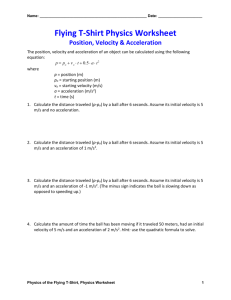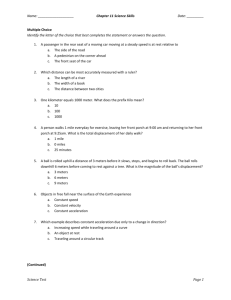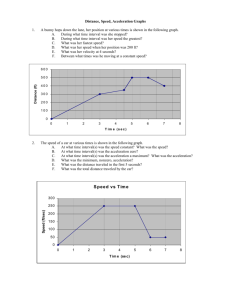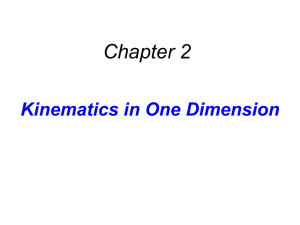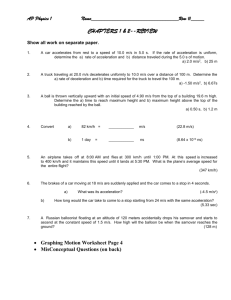1) Average speed is the total distance traveled divided by
advertisement
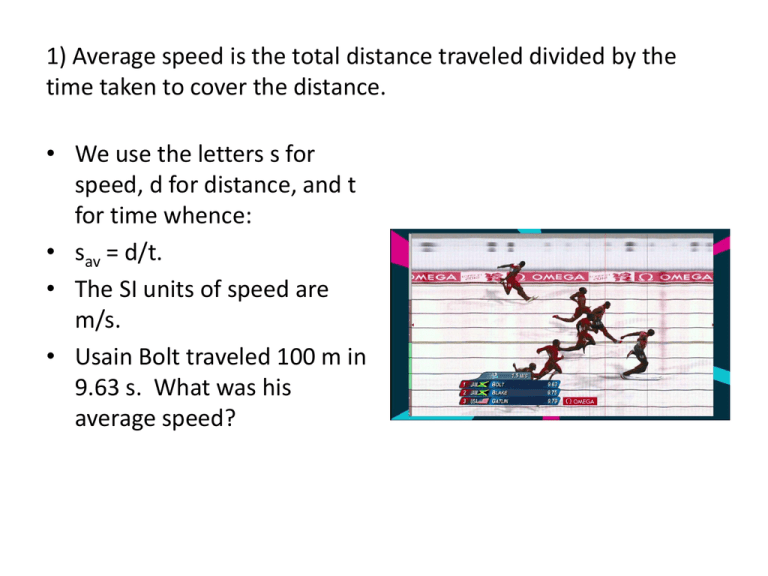
1) Average speed is the total distance traveled divided by the time taken to cover the distance. • We use the letters s for speed, d for distance, and t for time whence: • sav = d/t. • The SI units of speed are m/s. • Usain Bolt traveled 100 m in 9.63 s. What was his average speed? 2) A multi-exposure photograph is made in a totally dark room with a strobe and a camera with an open shutter. • If you travel 40 miles in 2 hours your average speed is sav = 40 mi/2 h = 20 mi/h = 20 mph. • Average speed tells you nothing about the details of the trip. • What is happening to the speed of the blue ball? 3) Instantaneous speed is equal to the average speed over a time interval that is very, very small. • For practical purposes we need a time interval that is small enough that the average speed does not change very much if we use an even smaller time interval. • Think of instantaneous speed as what a speedometer says. How does it work? 4) Velocity is speed and direction. The magnitude of velocity is speed. Quantities that have both magnitude and direction are called vectors. • Average velocity is displacement divided by time. vav = Dx/t. • Displacement is a vector quantity whose magnitude is the straight-line distance from A to B and whose direction is the direction from A to B. • Is the displacement vector ever longer than the distance traveled? 5) Average acceleration is the change in velocity divided by the time it takes to make that change. • We use the letters a for acceleration, v for velocity, and t for time whence: • aav = Dv/Dt. • The SI units of acceleration are m/s2. • When you travel in a straight line at a constant speed your acceleration is zero. • The falling ball accelerates! 6) According to Aristotle, a heavy physics text should fall significantly faster than a crumpled piece of paper. • According to Galileo, in a vacuum, the falling speeds of a cannonball and a feather should be equal. • Astronauts conducted an ultramodern demonstration of this on the Moon where a hammer and a feather fell at the same rate. • Why does the hammer fall faster on Earth? 7) As Galileo let balls roll down steeper ramps he discovered the following rule: the acceleration in each case is constant. • Constant acceleration means the speed changes by the same amount each second. • In the case of free fall the acceleration due to gravity is about 9.8 m/s2. • We use the letter g for this acceleration and usually round it off whence: • g = 10 m/s2. 8) If you throw a ball vertically upward with an initial speed of 20 m/s, one second later its instantaneous speed will be 10 m/s. • As the ball continues to rise against gravity it continues to lose speed. It will reach its maximum height in 2 seconds. • At that moment the instantaneous speed of the ball will be zero. • Is the ball rising or falling? Exercise 58 Exercise 60 Exercise 62 Exercise 64 Exercise 66 Exercise 68 Exercise 70 Exercise 72 Exercise 74 Exercise 76 Exercise 80

